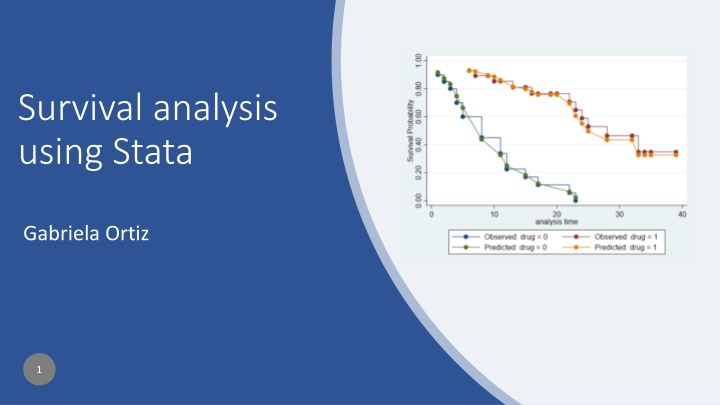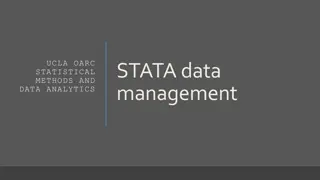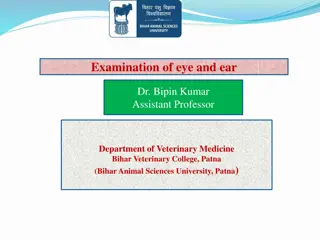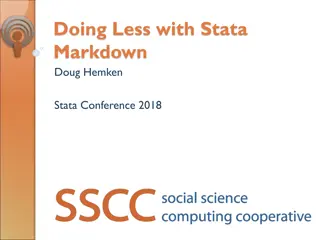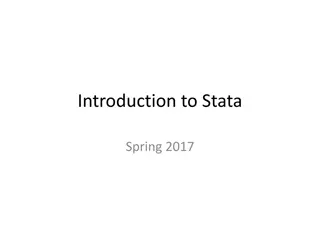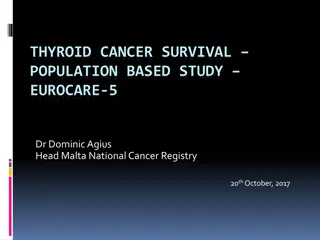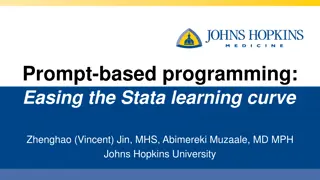Survival Analysis Using Stata - Overview and Data Examination
This content discusses survival analysis using Stata, covering topics such as survival-time data, exploratory graphs, estimation, models, predictions, diagnostics, testing assumptions, and more. It explains how survival-time data is measured and discusses various examples and scenarios related to survival data analysis.
Download Presentation

Please find below an Image/Link to download the presentation.
The content on the website is provided AS IS for your information and personal use only. It may not be sold, licensed, or shared on other websites without obtaining consent from the author.If you encounter any issues during the download, it is possible that the publisher has removed the file from their server.
You are allowed to download the files provided on this website for personal or commercial use, subject to the condition that they are used lawfully. All files are the property of their respective owners.
The content on the website is provided AS IS for your information and personal use only. It may not be sold, licensed, or shared on other websites without obtaining consent from the author.
E N D
Presentation Transcript
Survival analysis using Stata Gabriela Ortiz 1
Overview Introduction to survival-time data Summary statistics Exploratory graphs Estimation Semiparametric and parametric models Predictions Diagnostics Goodness-of-fit plots Testing assumptions 2
Introduction to survival data 3
Survival-time data We measure time to an event of interest The occurrence of the event is typically called a failure An observation is censored if we don t know the exact time of failure Survival-time data is present in many fields Health Economics Business Criminology Stata s st suite of commands is designed for analyzing survival-time data 4
A look at survival data One record per patient Patient ID Sex Days Died 1 Male 89 Yes 2 Female 91 No 3 Male 90 Yes 5
A look at survival data One record per patient Study ends Died Diagnosis Patient ID Sex Days Died 1 Male 89 Yes The patient s time of death is right-censored if they survive until the end of the study. 2 Female 91 No 3 Male 90 Yes 6
Single- vs. multiple-record data One record per patient Two records per patient Patient ID Sex Days Died Patient ID Sex Days Died 1 Male 33 No 1 Male 89 Yes 1 Male 89 Yes 2 Female 91 No 2 Female 33 No 3 Male 90 Yes 2 Female 91 No 3 Male 32 No 3 Male 90 Yes 7
Final notes on survival data There are other varieties A subject might be diagnosed before the study starts, meaning they are at risk before we observe them (delayed entry). There might be a gap between the time the subject entered the study and the time the study ended. Suppose the patient was traveling and unable to be reached for a month in the middle of the study but returned before the study ended. You might have multiple-failure data. We won t be focusing on these types of complications, but Stata s commands for analyzing survival-time data accommodate data with these features. 8
A look at survival-time data Before using Stata s st commands, we need to stset the data. 10
KaplanMeier survivor function . sts graph S(t)=Pr(T>t) 13
KaplanMeier survivor function by group . sts graph, by(surgery) risktable 14
Other statistics Incidence rates Obtain estimates and confidence intervals for the incidence-rate ratio (IRR) and incidence-rate difference. See [ST] stir. Obtain person-time and incidence rate. Also, merge with standard-rate data to obtain SMRs. See [ST] stptime. Failure rates Tabulate failure rates by multiple categorical variables Obtain stratified rate ratios Carry out trend tests See [ST] strate. Life tables Life, cumulative failure, and hazard tables Graph survival rate and corresponding confidence interval See [ST] ltable. 18
Cox proportional hazards model 20
Survivor and hazard functions ??????????? ?? ????????? ?????? ???? ? ?????? ?? ??????? ?? ???? ? . sts graph, surv saving(survival) . sts graph, hazard nob saving(hazard) . graph combine survival hazard 23
Cox proportional hazards model ? = 0? ??? ?1?1+ + ???? where 0? is the baseline hazard The hazard depends on the covariates; we estimate their coefficients (??). We assume the hazard ratio (exp(??)) is fixed over time. 24
Survivor function . stcurve, survival 26
Survivor function . stcurve, survival at1(drug=0 age=50) at2(drug=0 age=60) at3(drug=1 age=50) at4(drug=1 age=60) 27
Hazard function . stcurve, hazard at1(drug=0) at2(drug=1) 28
Assessing our model Statistics How well do our predictions agree with the outcomes? Does the proportional-hazards assumption hold? Diagnostic plots Plot of residuals versus time Log-log plots Comparison of the observed survival curve and the Cox predicted curve 29
Plotting Schoenfeld residuals versus time . estat phtest, plot(drug) 32
Log-log plot . stphplot, by(drug) 33
KaplanMeier and predicted survival plots . stcoxkm, by(drug) 34
More on the proportional-hazards assumption Graphical assessment of the proportional-hazards assumption Log-log plots Adjust the estimates to average values of specified variables Kaplan Meier and predicted survival plots Specify the method to handle tied failures Test the proportional-hazards assumption Test using Schoenfeld residuals Choose from other time-scale functions or specify your own function of time To learn more, see [ST]stcox PH-assumption tests. 35
Shared-frailty models 37
Shared-frailty models ??? = 0? ??? ???? + ?? where ?? is the effect of being in group i Observations within a group share the same frailty and are thus correlated Frailties are unobserved and can be predicted after fitting the model Analogous to regression models with random effects 38
Estimates of log frailties ??? = 0? ??? ???? ??? ?? 43
Other variations of the Cox model Stratified Cox regression Group specific baseline hazard . stcox x1 x2, strata(svar) Select another method to handle tied failures Efron, exact marginal-likelihood, or exact partial-likelihood Learn more about fitting a Cox proportional hazards model in [ST]stcox. 44
Competing risks regression models 45
Competing failure events Consider patients in an ICU after having a heart attack Model the time until a cardiac arrest If a patient dies, they are no longer at risk for cardiac arrest The event of death competes with our event of interest With this type of data, we want to focus on the cumulative incidence function 46
Cumulative incidence function CIF(t)=Pr(T t and event of interest) 47
Hazards for competing risks Hazard for a cardiac arrest: 1(?) Hazard for death: 2(?) Total hazard: (?) = 1(?) + 2? 1(?) Probability of the event being a cardiac arrest: 1(?)+ 2(?) Subhazard for cardiac arrest: 1? 48
Subhazard ? 1? ?? Cumulative subhazard: ?1 ? = 0 CIF1(?) =1- exp{-?1 (?)} This accounts for the fact that the cumulative incidence is a function of both hazards Model: 1?|x = 1,0? exp(x?) 49
